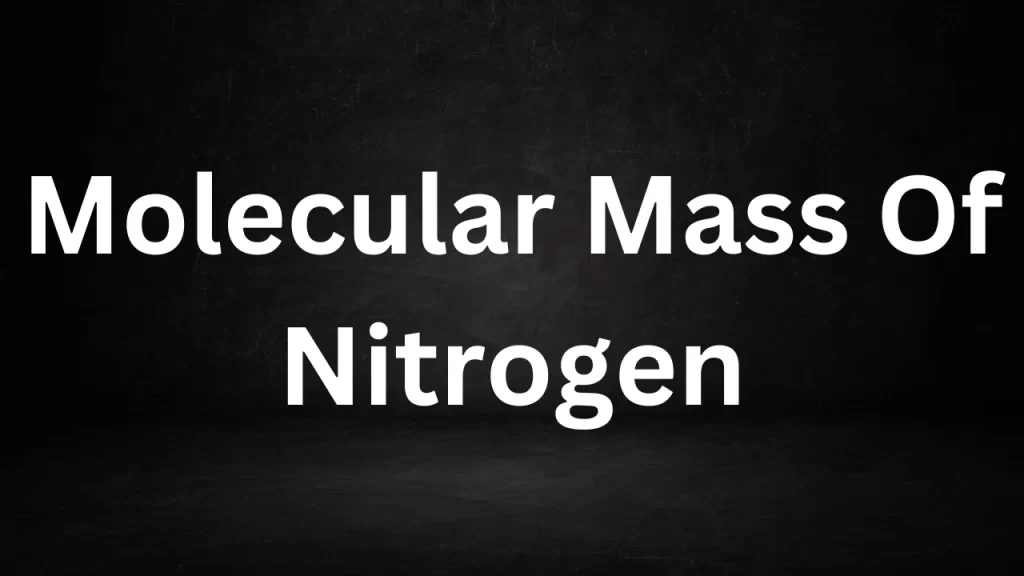Tag: nitrogen g mol
Molecular Mass Of N2
Molecular Mass Of N2: Molecular mass, also known as molecular weight, plays a crucial role in understanding the physical and chemical properties of substances.
It is a fundamental concept in chemistry, allowing us to quantify the mass of molecules and compounds. In this article, we will explore the mole mass of N2, or dinitrogen, and delve into why it’s a crucial component in the world of chemistry.

Molecular Mass Of N2
The Basics of Molecular Mass
Before we dive into N2’s molecular mass, let’s briefly review what molecular mass is and how it is calculated. Molecular mass represents the sum of the atomic masses of all the atoms in a molecule. This sum is typically expressed in atomic mass units (amu) or unified atomic mass units (u). To calculate the mole mass of a compound, you add up the atomic masses of all the atoms in the molecule based on the periodic table.
Understanding N2 (Dinitrogen)
N2, or dinitrogen, is the most abundant gas in Earth’s atmosphere, making up approximately 78% of the air we breathe. It consists of two nitrogen atoms (N) bonded together by a strong covalent bond. To determine the mole mass of N2, we need to consider the atomic masses of nitrogen atoms.
The atomic mass of nitrogen (N) is approximately 14.00674 amu. Since N2 contains two nitrogen atoms, we can calculate its mole mass as follows:
Molecular Mass of N2 = 2 × Atomic Mass of Nitrogen (N)
The Molecular Mass of N2 = 2 × 14.00674 amu
Molecular Mass of N2 ≈ 28.01348 amu
So, the mole mass of dinitrogen (N2) is approximately 28.01348 amu.
Significance of N2’s Molecular Mass
- Atmospheric Composition: Understanding the mole mass of N2 is crucial for comprehending the composition of Earth’s atmosphere. Nitrogen gas (N2) makes up the majority of the air, and its molecular mass helps scientists and meteorologists analyze the properties of the atmosphere, including its density and pressure.
- Chemical Reactions: Molecular mass is fundamental in chemical reactions. When chemists balance chemical equations, they take into account the molecular masses of reactants and products to ensure the conservation of mass. N2 participates in a wide range of chemical reactions, including those found in the Haber-Bosch process for ammonia production, as well as combustion reactions in engines and industrial processes.
- Avogadro’s Hypothesis: The mole mass of N2 plays a role in Avogadro’s hypothesis, which states that equal volumes of gases at the same temperature and pressure contain an equal number of molecules. N2 is frequently employed as a standard gas in gas stoichiometry owing to its abundance and precisely known molecular mass.
- Analytical Chemistry: In the field of analytical chemistry, the molecular mass of N2 finds application in methods such as mass spectrometry. It helps researchers identify and quantify unknown substances by comparing the molecular mass of their fragments to known values.
Conclusion
Understanding the mole mass of N2 (dinitrogen) is essential in various fields of science and industry. With a molecular mass of approximately 28.01348 amu, N2 plays a significant role in the composition of Earth’s atmosphere, chemical reactions, and analytical chemistry. This fundamental knowledge helps us better grasp the behavior of gases, the principles of stoichiometry, and the composition of the air we breathe. The mole mass of N2 serves as a cornerstone in the world of chemistry and is a vital concept for anyone studying the natural sciences.
Read More
- Molar Mass Of I
- Molecular Weight Of Cl
- Molecular Mass Of Sodium Carbonate
- Molecular Mass Of Nitric Acid
- Molecular Mass Of Sulphuric Acid
Frequently Asked Questions (FAQs) On Molecular Mass Of N2
1. What is N2, and why is it important to know its molecular mass?
N2, also known as dinitrogen, is a diatomic molecule composed of two nitrogen atoms bonded together. Its mole mass is essential to understand various aspects of chemistry, including chemical reactions, atmospheric composition, and analytical techniques.
2. What is the molecular mass of N2?
The mole mass of N2 is approximately 28.01348 atomic mass units (amu).
3. How is the molecular mass of N2 calculated?
To calculate the mole mass of N2, you add up the atomic masses of the two nitrogen (N) atoms in the molecule. Since the atomic mass of nitrogen is approximately 14.00674 amu, the mole mass of N2 is 2 times this value.
4. Why is N2’s molecular mass important in the field of chemistry?
N2’s molecular mass is crucial because it is involved in various chemical reactions, serves as a reference gas in gas stoichiometry, and plays a role in Avogadro’s hypothesis, which is fundamental in understanding the behavior of gases.
5. How does N2 contribute to Earth’s atmosphere?
N2 is the most abundant gas in Earth’s atmosphere, making up approximately 78% of the air we breathe. Its molecular mass influences the density and pressure of the atmosphere, affecting weather patterns and other atmospheric processes.
Molecular Mass Of Nitrogen
Molecular Mass Of Nitrogen: When it comes to the elemental composition of our universe, nitrogen plays a vital role. It is one of the most abundant elements on Earth, making up approximately 78% of our atmosphere.
Nitrogen is a non-metal gas known for its importance in the sustenance of life and its presence in various compounds. One fundamental aspect of N2 is its molecular mass, which is crucial in various scientific and industrial applications.

Molecular Mass Of Nitrogen
The Basics of Molecular Mass
Molecular mass, also known as molecular weight or molar mass, is a fundamental concept in chemistry. It is defined as the mass of a molecule, which is the sum of the masses of all the atoms in that molecule.
The unit of molecular mass is the unified atomic mass unit (u), which is defined relative to the mass of a carbon-12 atom. The molecular mass of a compound is typically expressed in atomic mass units.
The Composition of Nitrogen Molecule
In the case of N2, the most common and stable form found in nature is the N2 molecule (N2). This molecule consists of two nitrogen atoms bonded together by a strong triple covalent bond. To determine the molecular mass of N2, we need to consider the individual masses of the nitrogen atoms that compose it.
Atomic Mass of Nitrogen
The atomic mass of an element is the weighted average of the masses of its naturally occurring isotopes. Nitrogen has two stable isotopes, nitrogen-14 (14N) and nitrogen-15 (15N), with natural abundances of approximately 99.63% and 0.37%, respectively.
The atomic mass of nitrogen-14 is approximately 14.00307 atomic mass units (u), and the atomic mass of nitrogen-15 is approximately 15.00011 u.
Calculating the Molecular Mass of Nitrogen (N2)
Now that we know the atomic masses of N2 isotopes, we can calculate the molecular mass of nitrogen (N2). Since there are two N2 atoms in an N2 molecule, we simply add the masses of these two atoms together:
Molecular Mass of N2 = (Atomic Mass of Nitrogen-14) x 2
Molecular Mass of N2 ≈ (14.00307 u) x 2 ≈ 28.00614 u
Rounded to four decimal places, the molecular mass of nitrogen (N2) is approximately 28.0061 atomic mass units (u).
Significance of Nitrogen’s Molecular Mass
Understanding the molecular mass of nitrogen is crucial in various scientific and industrial applications. For instance:
- Chemical Reactions: Chemists use molecular masses to balance chemical equations and determine reaction stoichiometry, which helps in predicting the amounts of reactants and products.
- Gas Properties: The molecular mass of N2 is important in understanding its physical properties, including its behavior as a gas in various conditions and its role in gas mixtures.
- Environmental Science: Researchers use the molecular mass of N2 to study N2 cycles and its impact on ecosystems, as well as its contribution to air pollution.
- Industrial Processes: In industries such as food processing and electronics manufacturing, the molecular mass of N2 is critical for controlling and optimizing production processes.
- Aviation and Space Exploration: Engineers and scientists consider the molecular mass of N2 in the design and operation of aircraft and spacecraft, as N2 is a significant component of the atmosphere.
- In conclusion, the molecular mass of nitrogen (N2), which is approximately 28.0061 atomic mass units (u), is a fundamental property of this essential element.
- It plays a pivotal role in various scientific and industrial fields, contributing to our understanding of chemistry, physics, and the natural world.
Read More
- Molecular Weight Of Glucose
- Molecular Mass Of Oxygen
- Difference Between Light Microscope And Electron Microscope
- Molar Mass Of Aluminium
- Molecular Mass Of Glucose
Frequently Asked Questions (FAQs) Molecular Mass Of Nitrogen
1. What is the molecular mass of nitrogen (N2)?
The molecular mass of nitrogen (N2) is approximately 28.0061 atomic mass units (u). This value is calculated by adding the atomic masses of the two N2 atoms that compose the N2 molecule.
2. Why is it important to know the molecular mass of nitrogen?
Knowing the molecular mass of N2 is essential in various scientific and industrial applications. It helps chemists balance chemical equations, understand gas properties, study environmental impacts, and optimize industrial processes.
3. How is the molecular mass of N2 calculated?
The molecular mass of nitrogen (N2) is calculated by adding the atomic masses of the two N2 atoms in the molecule. Since there are two nitrogen atoms, you simply multiply the atomic mass of nitrogen by 2.
4. What are the isotopes of N2, and how do they affect its molecular mass?
N2 has two stable isotopes: nitrogen-14 (14N) and N2-15 (15N). These isotopes have slightly different atomic masses. The molecular mass of N2 takes into account the weighted average of these isotopes based on their natural abundances, resulting in a molecular mass of approximately 28.0061 u.
5. How does nitrogen’s molecular mass impact its behavior as a gas?
The molecular mass of N2 influences its physical properties as a gas. It affects factors such as density, boiling point, and solubility. Nitrogen’s molecular mass plays a role in its behavior in various gas mixtures and its importance in industrial applications.
},{
“@type”: “Question”,
“name”: “4. What are the isotopes of nitrogen, and how do they affect its molecular mass?”,
“acceptedAnswer”: {
“@type”: “Answer”,
“text”: “Nitrogen has two stable isotopes: nitrogen-14 (14N) and nitrogen-15 (15N). These isotopes have slightly different atomic masses. The molecular mass of nitrogen takes into account the weighted average of these isotopes based on their natural abundances, resulting in a molecular mass of approximately 28.0061 u.”
}
},{
“@type”: “Question”,
“name”: “5. How does nitrogen’s molecular mass impact its behavior as a gas?”,
“acceptedAnswer”: {
“@type”: “Answer”,
“text”: “The molecular mass of nitrogen influences its physical properties as a gas. It affects factors such as density, boiling point, and solubility. Nitrogen’s molecular mass plays a role in its behavior in various gas mixtures and its importance in industrial applications.”
}
}]
}